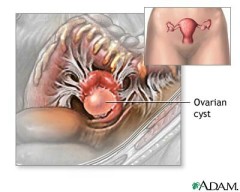 Many women commonly produce ovarian cysts. These cyst structures, called follicles, contribute to the menstrual cycle by producing the hormones used by the ovaries to stimulate the release of an egg into the uterus. The follicle then commonly ruptures without causing the ovaries any harm. Once the follicle has ruptured it is not uncommon for a functional ovarian cyst to develop. There are two types of functional ovarian cyst; follicular cysts, an enlarged follicle filled with fluid, and corpus luteum cysts, filled with either fluid or blood. However, these cysts are also harmless to the ovaries and over the course of a few months they tend to decrease in size and disappear. It is when this process goes abnormally that a complex ovarian cyst may develop.
Many women commonly produce ovarian cysts. These cyst structures, called follicles, contribute to the menstrual cycle by producing the hormones used by the ovaries to stimulate the release of an egg into the uterus. The follicle then commonly ruptures without causing the ovaries any harm. Once the follicle has ruptured it is not uncommon for a functional ovarian cyst to develop. There are two types of functional ovarian cyst; follicular cysts, an enlarged follicle filled with fluid, and corpus luteum cysts, filled with either fluid or blood. However, these cysts are also harmless to the ovaries and over the course of a few months they tend to decrease in size and disappear. It is when this process goes abnormally that a complex ovarian cyst may develop.
There are various types of complex ovarian cysts, including dermoid cysts, endometriomas, and cystadenomas. Each develops in a slightly different way to the others.
Dermoid cysts – Dermoid cysts, also known as benign mature cystic teratoma, can contain various types of tissues, such as hair, fragments of bone, and fat tissues, due to being made up of the cells in the eggs stored in the ovaries. As a result, dermoid cysts can be large, growing up to around 15cm in length. These cysts can run in families, and often develop in both ovaries. Dermoid cysts tend to resolve themselves though, often after a few months.
Endometriomas – Endometriomas are formed if women suffer from the condition of endometriosis. In this condition, endometrial tissue, which normally internally lines the uterus, is found on the outside of the uterus. Cysts can be formed as a result, filling up with blood. Endometriomas are often known as the chocolate cysts, due to the observation that the dried blood within the cysts resembles chocolate.
Cystadenomas – Cystadenomas develop from the cells forming the outer side of the ovaries, including the stalk. Mucinous cystadenomas are filled with a mucus fluid, while serious cystadenomas are filled with a thinner fluid. As a result of growing on the stalk of the ovaries, these cysts run the risk of torsion, a particularly painful incident where the cyst blocks the blood flow into the ovary or the cyst itself. Although usually benign, some of these cysts can be cancerous.
Polycystic ovary syndrome – During this syndrome many small cysts develop in your ovaries. This may be caused by a hormone imbalance, period difficulties, obesity, acne, and reduced fertility.
Other types of cyst are known to develop, although these are rare compared to the types of cysts listed above. These cysts should not be confused with ovarian tumours which may also develop, but which are solid rather than containing fluid.
Monday, February 15, 2010
Ovarian Cysts' Types
 Admin on
Admin on  12:33 AM
12:33 AM

















0 komentar:
Post a Comment